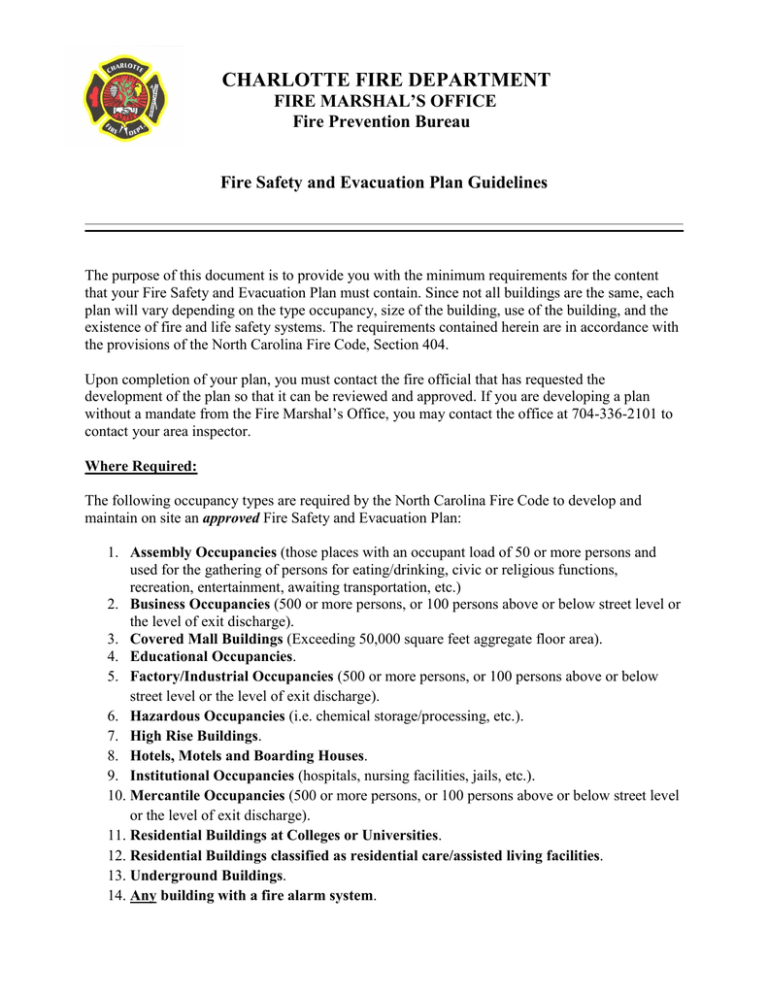CHARLOTTE FIRE DEPARTMENT FIRE MARSHAL’S OFFICE Fire Prevention Bureau
advertisement

CHARLOTTE FIRE DEPARTMENT FIRE MARSHAL’S OFFICE Fire Prevention Bureau Fire Safety and Evacuation Plan Guidelines The purpose of this document is to provide you with the minimum requirements for the content that your Fire Safety and Evacuation Plan must contain. Since not all buildings are the same, each plan will vary depending on the type occupancy, size of the building, use of the building, and the existence of fire and life safety systems. The requirements contained herein are in accordance with the provisions of the North Carolina Fire Code, Section 404. Upon completion of your plan, you must contact the fire official that has requested the development of the plan so that it can be reviewed and approved. If you are developing a plan without a mandate from the Fire Marshal’s Office, you may contact the office at 704-336-2101 to contact your area inspector. Where Required: The following occupancy types are required by the North Carolina Fire Code to develop and maintain on site an approved Fire Safety and Evacuation Plan: 1. Assembly Occupancies (those places with an occupant load of 50 or more persons and used for the gathering of persons for eating/drinking, civic or religious functions, recreation, entertainment, awaiting transportation, etc.) 2. Business Occupancies (500 or more persons, or 100 persons above or below street level or the level of exit discharge). 3. Covered Mall Buildings (Exceeding 50,000 square feet aggregate floor area). 4. Educational Occupancies. 5. Factory/Industrial Occupancies (500 or more persons, or 100 persons above or below street level or the level of exit discharge). 6. Hazardous Occupancies (i.e. chemical storage/processing, etc.). 7. High Rise Buildings. 8. Hotels, Motels and Boarding Houses. 9. Institutional Occupancies (hospitals, nursing facilities, jails, etc.). 10. Mercantile Occupancies (500 or more persons, or 100 persons above or below street level or the level of exit discharge). 11. Residential Buildings at Colleges or Universities. 12. Residential Buildings classified as residential care/assisted living facilities. 13. Underground Buildings. 14. Any building with a fire alarm system. Contents: Your Fire Safety and Evacuation Plan should, at a minimum, contain the following information: Building Information: 1. General description of building including fire and life-safety systems that may be present. 2. Name of emergency contacts and phone numbers. 3. Name of the designated “Impairment Coordinator” and Fire Wardens (if applicable). Fire Safety and Evacuation Procedures: 1. 2. 3. 4. 5. 6. 7. 8. 9. Emergency egress or escape routes and whether full or partial evacuation (if approved). Procedure for employees that must remain to operate critical equipment, if approved. Procedures for assisting those that cannot exit or negotiate stairs without assistance. Procedures for accounting for all employees after evacuation. Identification of any personnel designated to rescue or render emergency care. The procedures of notifying employees of a fire or other emergency. The primary and any secondary means of notifying the Fire Department. A description (if applicable) of any emergency voice communication system. Identification of any personnel on site who is responsible for overseeing, operating, and/or maintaining equipment installed to prevent or control fires. 10. A list of any major or unusual fire hazards such as storage tanks for hazardous materials, other on-site chemical storage or processing, etc. 11. Identification of personnel designated for maintenance of or control of fuel hazard sources. 12. Identification of person in charge of overseeing any impairment of any fire protection or life-safety systems (“Impairment Coordinator”). 13. Designated meeting/assembly point outside of structure. Site and Floor Plans: 1. A site plan indicating: The evacuation assembly point(s) for all employees and staff. The location of on-site private fire hydrants (if applicable). Vehicle access to the property. 2. A Floor plan indicating: Exits. Primary evacuation routes. Secondary evacuation routes. Areas of refuge (if applicable). Exterior areas where assisted rescue may be needed (ex. balcony, etc.). Location of manual fire alarm boxes, fire sprinkler riser valves, fire alarm control panel, fire extinguishers, other fixed specialized extinguishing systems, etc. Location of fuel source shut-off valves, main electrical rooms, etc.



